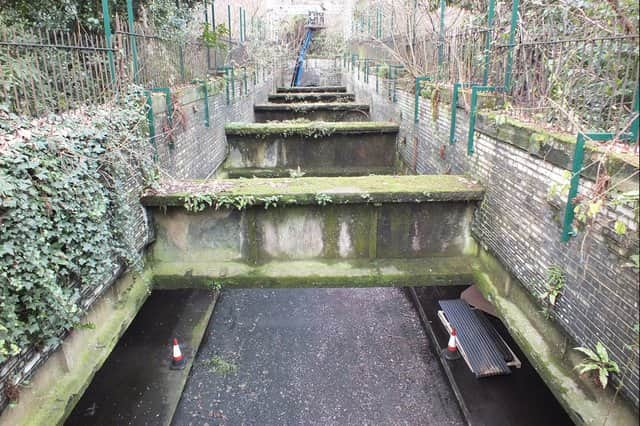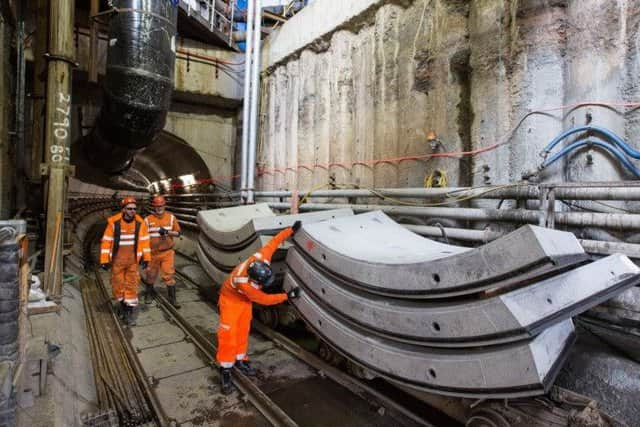Glasgow’s hidden tunnels: uncovering the forgotten underground world beneath our city
and live on Freeview channel 276
Edinburgh is famed for its underground network of tunnels and vaults, but did you know that Glasgow is also home to a subterranean web of passageways and abandoned stations ?
Botanic Gardens Station
One such passage was uncovered over the weekend, as film crew for the new Batgirl movie utilised the abandoned Botanic Gardens Station, stationing a ‘Gotham Transit Authority’ Subway car at the station.
Advertisement
Hide AdAdvertisement
Hide AdIt will be the first time a carriage has been spotted at the station which has been out of use as a transport hub since 1939.
The station was reimagined as a nightclub in 1970 but was then closed down due to a fire reportedly caused by a cigarette during a battle of the bands contest.
The station was originally opened in 1896 and was an instantly recognisable landmark in the West End due to the station’s distinctive onion dome towers.
The ventilation openings and the platforms of the old station can still be viewed from the gardens themselves
Advertisement
Hide AdAdvertisement
Hide AdThe abandoned station can be reached via a 220 yard underground passageway known as the Botanic Gardens tunnel.


Central Station tunnels
From an abandoned train station to Glasgow’s busiest, Central Station sits atop of a labyrinth of once-busy channels.
Network Rail operates a tour of the underground world which navigates you through the passageways highlighting now abandoned railway vaults which were once the engine room that drove Glasgow’s industrial expansion to become ‘The Second City of The British Empire’.
The underground world is also tinged with tragedy, with the station once serving as a mortuary during World War 1.
Harbour Tunnel Rotundas
Advertisement
Hide AdAdvertisement
Hide AdNow home to the Cranside Kitchen, one of the city’s most trendy dining and drinking venues, Glasgow’s distinctive north harbour tunnel rotunda once served a rather different purpose.
One of two access points to a tunnel system which allowed pedestrians, horsedrawn waggons and small vehicles to cross the water when this end of the city was filled with warehouses and dock workers.
Closed in 1980, it was left empty for more than three decades.
You can see the linking south rotunda on the opposite side of the Clyde which has now been converted into an office space.
Advertisement
Hide AdAdvertisement
Hide AdThe north and south rotundas were built in the early 1890s to provide cover for the existing lift shafts that allowed vehicles to cross under the Clyde.
Three tunnels - two for goods traffic and one for pedestrians - were by then in operation.
The river was so busy with shipping the nearest bridge was almost a mile downstream in Glasgow city centre. Tunnels allowed goods - and dockers - to quickly pass from one bank to another.
The ‘football tunnel’ at Central Station
Football fans of an older generation will remember Central Station’s famed Football Tunnel.
Advertisement
Hide AdAdvertisement
Hide AdIn years gone by football fans travelling from the city centre to Hampden would have had to enter the station from the opposite end of the complex, near the current low-level station, and be directed along a passageway known as the “football tunnel”, which ran at right angles under the platforms.
The system left the station concourse clear for use by opposing fans – such as England’s – who would be sent from there onto their own dedicated trains to Hampden from other platforms.
Glasgow Central tour guide and local historian Paul Lyons previously detailed the tunnel to The Scotsman.
He said: “The ‘football tunnel’ was used to segregate the crowds when Hampden saw attendances of 100,000.
Advertisement
Hide AdAdvertisement
Hide Ad“Scotland fans came in via Hope Street [on the west side of the station], while England fans came in from Gordon Street [the main entrance, on the north side].”
General Post Office tunnel network
At the junction of Cathedral Street and North Hanover Street a curious standalone building once served as a lift shaft which connects street level to a series of tunnels.
The expansive network runs from the Royal Infirmary to the telephone exchange, or ‘Dial House’, on Bothwell Street and runs beneath the city’s subway lines.
The telephone exchange is at the heart of the network and was commissioned by the General Post Office (GPO) to host the general processor for the west of Scotland.
Advertisement
Hide AdAdvertisement
Hide AdBuilt in the 1950s with the Cold War in mind, the exchange was built to withstand a nuclear bomb attack on Glasgow.
Rumours surround the web of tunnels with some claiming that they served as an escape route for GPO staff to a bomb shelter under George Square.
The Shieldhall Tunnel (and its Saint)


This tunnel runs for more than three miles from Craigton to Queen’s Park, under Bellahouston and Pollok parks, and was constructed to help improve river water quality and tackle flooding in parts of the city.
It was Scottish Water’s £100m project and was part of the biggest upgrade in the Greater Glasgow area’s waste water infrastructure since Victorian times.
Advertisement
Hide AdAdvertisement
Hide AdEngineers working on the tunnel, which was completed in 2020, had a special 'safety' measure in place - a small statuette in a wooden case at the tunnel mouth. Saint Barbara is the patron saint of tunnellers and miners because of their use of explosives and her association with lightning.
Comment Guidelines
National World encourages reader discussion on our stories. User feedback, insights and back-and-forth exchanges add a rich layer of context to reporting. Please review our Community Guidelines before commenting.